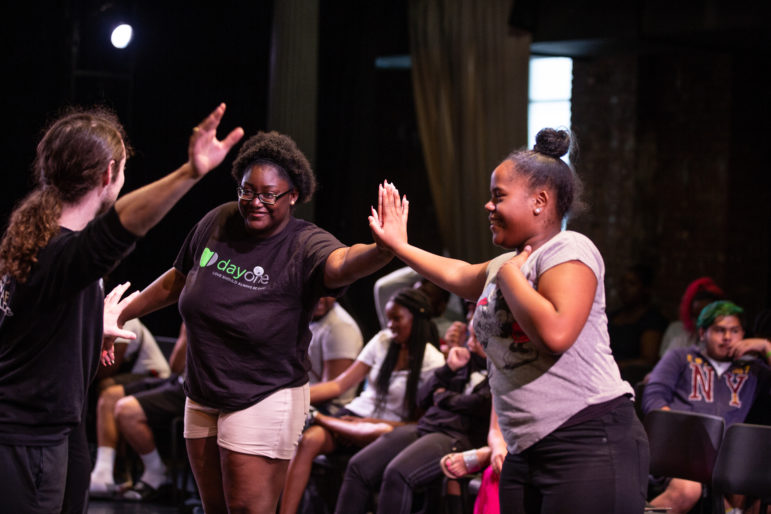
Scott Shaw
Gibney staff say the parallels between dance and life give weight to its work.
Four dancers glide across the floor, holding hands and leaping in tandem. Suddenly, they and the music are interrupted by the sound of incoming text messages that demand to know “What are you doing?” “Where are you?” “Who are you with?” The questions cause one of the dancers to lose focus and to break away from the others.
This performance is one of four in the repertoire of “Hands are for Holding,” a program created by the dance center Gibney to fuel discussions about healthy relationships and intimate-partner violence with students in grades four through 12. Each assembly features four dancers and a community educator who facilitates a post-performance conversation.
“We utilized the dances as a proxy for the conversation because what makes a healthy dance is often the same thing that makes a healthy relationship,” says Kara Gilmour, the center’s senior director of community training and outreach. “Communication, patience, equity — without those a dance falls apart.”
Gibney is more than a dance school. Yasemin Ozumerzifon, director of community action, says it has worked with survivors of intimate-partner violence since 2000 and realized a few years ago that they also wanted to focus on prevention through dialogue with young people.
“Hands are for Holding” held its first assembly in 2014, in conjunction with Day One, a youth-focused organization aiming to end dating abuse and domestic violence. The program expanded this year thanks to the Mayor’s Grant for Culture Impact, which funded six-month partnerships between city offices and cultural organizations. Gibney, along with six other groups, was one of the first to receive this $50,000 grant.
The Mayor’s Office to End Domestic and Gender-Based Violence has been working with “Hands are for Holding” since 2015, but this year is the first time the program received city funds. Five recipients for the second iteration of the grant will be announced in January 2019.
Gilmour says the grant legitimized Gibney’s effort and that she’s excited to see the city investing in art as a form of activism.
“It’s a true testament to the city acknowledging in a very significant way that arts are integral to creating systemic change,” Gilmour says. “They are not an add-on, they are not a nice-to-have but that they are a core piece of really changing the way society functions.”
The grant allowed Gibney to host assemblies in more schools (75 last school year) and pilot a 10-week residency program that teaches smaller groups of students about healthy relationships and communication.
“We know that kids learn from other kids and we know that a deeper dive is more significant,” Ozumerzifon says. “Having the intimacy and the commitment of that partnership as well as the time and the funding to go into the schools and pilot those was key.”
“Hands” is committed to doing four residencies during the 2018-2019 school year.
Megan Minturn, a dance teacher at Brooklyn International High School, says her school has worked with “Hands are for Holding” since 2014. Ten of her students are currently completing a residency, focusing their dance on the pros and cons of technology.
“There are two really talented dance artists who are offering the program and working with the students and I think it’s rare,” says Minuturn, who is present at the weekly sessions. “It might seem like a minute element but I think that students realize that what we’re doing is special and important when there are three adults in the room sharing these experiences and discussions with them.”
City Limits’ reporting on the intersection of art and policy is supported by the Laurie M. Tisch Illumination Fund. City Limits is solely responsible for all content.








